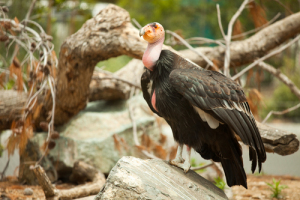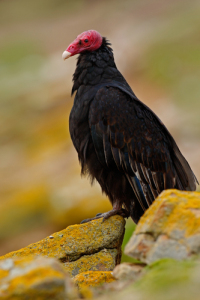Learn all about vultures with fascinating facts you may have never heard of before!
Witten by: Niki Giovanis
What are Vultures?
Vultures are a group of birds that belong to two orders, Accipitriformes and Cathartiformes. They are classified as being birds of prey. To refresh everyone’s memory, birds of prey primarily hunt and feed on vertebrates such as fish, other birds, small rodents, and more. The vulture species can be divided into what is known as the “old world vultures,” which encompasses 16 species that are generally found in Africa, Europe, and Asia, as well as the “new world vultures” that contains 7 species that are found throughout North and South America. However, although these two families are often grouped together, they are quite distantly related.

What are the Characteristics of Vultures?
Vultures are most notably identified by their large, hunched stature, broad wingspan, and featherless heads. All vultures have strong hooked beaks that allow them to hunt efficiently and tear the carcass of their prey open with ease. Each species of vulture has a different distinct feather and color pattern. Generally speaking, vultures can range anywhere from 60 to 1.4 m(2′ to 4’7″) in length with a maximum weight of 33 pounds(15 pounds) and a wingspan of up to 3.2 meters(10’6″); however, this will range amongst the species.
For example, the smallest vulture species is the Egyptian Vulture(Neophron percnopterus), while the largest vulture is the Andean Condor(Vultur gryphus).

Vulture Reproduction
Vultures reach sexual maturity between 5 to 8 years of age. Most species of vulture mate for life and are monogamous with one another. While the females of larger species of vultures usually lay one egg, smaller species can lay anywhere from 2 to 3. Additionally, depending on the species, the eggs are incubated anywhere from 28 to 68 days.
Vulture Habitat
As mentioned, vultures are separated into two families; the new world vultures and the old world vultures, which determines where they originate worldwide. Let’s take a look at the individual habitats of each family as they differ from one another.
New World Vultures
New world vultures are found in the western hemisphere and can be found anywhere from Canada to South America. Naturally, the new world vulture species inhabit various ecosystems due to the wide spectrum of climates, from mountain ranges, deserts to tropical forests, and are typically able to adapt to the ecosystem that they live in. They are also known to be well adjusted to humans and will emerge from their nests to feed on roadkill and other animals.
Old World Vultures
On the other hand, old-world vultures are found throughout Asia, Africa, and Europe. old-world vultures inhabit deserts, grasslands, and savannas.
What do Vultures Eat?
As stated previously, vultures are birds of prey, meaning they like to feast on other animals. However, while other birds of prey species hunt and feed on live prey, vultures prefer to eat animals that are already dead and decaying. They will swoop down from the tops of trees and fly low to the ground, where they will search for anything from food scraps to dead elephants and other wild animals.
As a vulture’s diet is mainly dead animals, they come into contact with various diseases that would kill other animals. However, because as they can digest meat exceptionally well and have stomachs that contain a corrosive acid, they can remain healthy from diseases. Furthermore, vultures are highly notorious for eating the meat, skin, and feathers of their prey. In contrast, some vultures are even known to eat the bones.
How do Vultures Defend themselves?
When vultures feel threatened by other animals such as snakes, hawks, and large wild animals they defend themselves by vomiting on the animals that are attacking them as their stomach acid is corrosive and toxic.
A Closer Look at Vulture Species
Now that we have an overview of vultures as a whole, we are going to take a look at one of the most popular vultures from each family a little bit closer.

The Turkey Vulture
One of the most well-known new world vulture species is the Turkey Vulture. The Turkey Vulture is characterized by how large they are. They range anywhere from 64 to 81 cm(2’1″ to 2’8″) in length and a wingspan between 1.7 to 1.8 m(5’7″ to 5’11”). They have a distinct coloring that looks black from far away; however, it is a dark brown color when you approach closer. Like all vultures, they have a bald head. They may inhabit suburban areas where they can eat garbage and roadkill. Furthermore, they are known to flock in small groups and are known to be majestic in their flight.
The Cinereous Vulture
On the other hand, one of the most famous old world vultures is the Cinereous Vulture. They are known as one of the largest and heaviest vultures in the world. With a length of 98 to 1.2 m(3’2.6″ to 3’11.2″) and a wingspan of 2.5 – 3.1 m(8’2″-10’2″) long, this majestic bird soars through the air with might and elegance. The Cinereous Vulture can weigh up to 31 pounds(14.1 kilograms). Furthermore, these birds are known to live in European countries such as Greece. While the species did become extinct in Italy, Portugal, France, and Poland, there have been successful efforts in other countries in Europe that are breeding and redistributing the species back into those areas.
Interesting Vulture Facts
Now that we understand these incredible birds let’s look at some exciting vulture facts that you may not have previously been aware of!
- Of the 23 species of vultures that exist, over half of them are deemed either threatened, endangered, or critically endangered as a consequence of human influence.
- The Andean Condor is the largest of all the vulture species, reaching a wingspan of almost 3.5 meters(11’5.8″) crosswise!
- New world vultures lack the ability to produce songs like many other species of birds. Instead, they are limited to simple sounds, including grunts and hisses that can be quite intimidating.
- Old World vultures do not have a good sense of smell. Therefore they rely solely on their unbelievable eyesight to locate food.
- Vultures can eat up to 20% of their own body weight in one sitting.
- A group of vultures is called a venue.
- To keep cool on a warm summer’s day, vultures will urinate on their legs and feet to kill bacteria.
Final Thoughts
As you can see, there are so many incredible and interesting facts related to vultures. From their large stature to their abilities to fly at high altitudes, they are indeed a sight to see in the wild.
